Landscaping in Lambeth: Transforming Outdoor Spaces
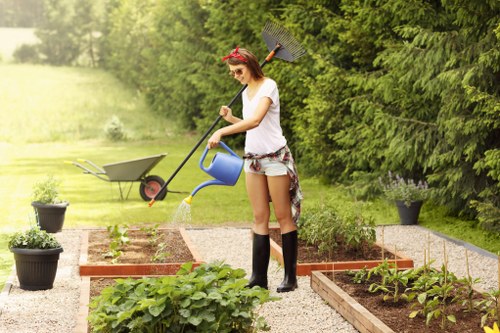
The Importance of Professional Landscaping
**Landscaping in Lambeth** plays a crucial role in enhancing the aesthetic appeal and functionality of outdoor spaces. Whether you're a homeowner looking to create a serene garden or a business aiming to impress clients with a beautifully maintained exterior, professional landscaping services can make all the difference.
In a bustling urban area like Lambeth, having a well-designed landscape provides a sanctuary from the hectic city life. Thoughtfully planned gardens, patios, and green spaces not only improve the visual appeal of a property but also contribute to the overall well-being of its occupants.
Moreover, effective landscaping can increase property value. A meticulously maintained garden and outdoor area are attractive features that potential buyers or tenants often look for, making your property more competitive in the market.
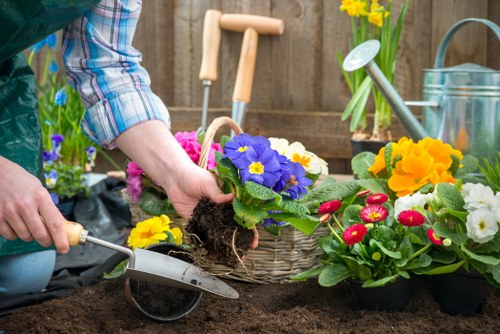
Key Services Offered by Landscaping Professionals in Lambeth
**Landscaping services in Lambeth** encompass a wide range of offerings tailored to meet diverse client needs. Some of the most common services include:
- Garden Design and Installation: Creating bespoke garden layouts that reflect the client's vision and complement the property's architecture.
- Lawn Care and Maintenance: Regular mowing, fertilizing, and pest control to keep lawns healthy and vibrant.
- Hardscaping: Installation of patios, walkways, retaining walls, and other non-plant elements that add structure and functionality to outdoor spaces.
- Planting Services: Selection and planting of trees, shrubs, flowers, and other vegetation that thrive in Lambeth's climate.
- Irrigation Systems: Designing and installing efficient watering systems to ensure plants receive adequate moisture.
These services are essential for maintaining a beautiful and sustainable landscape that can withstand the local weather conditions and urban environment.
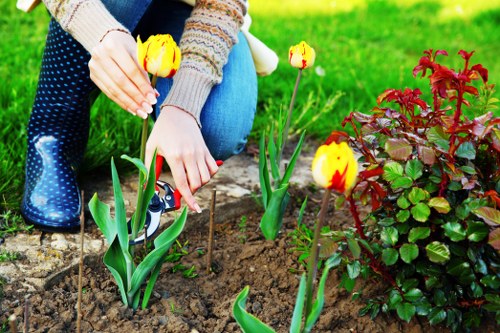
Choosing the Right Landscaping Company in Lambeth
Selecting a reputable landscaping company in Lambeth is vital to achieving the desired results. Here are some factors to consider when making your choice:
- Experience and Expertise: Look for companies with a proven track record and extensive knowledge of local plant species and design trends.
- Portfolio: Review the company's previous projects to gauge their style and quality of work.
- Customer Reviews: Check testimonials and reviews to understand the company's reputation and client satisfaction levels.
- Licensing and Insurance: Ensure the company is properly licensed and insured to protect yourself from any liabilities.
- Comprehensive Services: Choose a company that offers a full range of services to meet all your landscaping needs in Lambeth.
Taking the time to research and select the right company will ensure that your landscape transformation is smooth and meets your expectations.
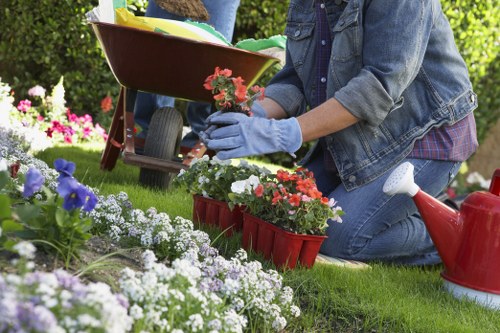
Popular Landscaping Trends in Lambeth
**Landscaping trends in Lambeth** are continually evolving, influenced by global design movements and local preferences. Some of the most popular trends currently include:
- Sustainable Landscaping: Incorporating eco-friendly practices such as using native plants, rainwater harvesting, and reducing chemical usage.
- Outdoor Living Spaces: Creating functional areas for entertainment and relaxation, including outdoor kitchens, fire pits, and comfortable seating arrangements.
- Vertical Gardens: Maximizing space by growing plants vertically on walls and structures, ideal for smaller urban gardens.
- Low-Maintenance Gardens: Designing gardens that require minimal upkeep by selecting hardy plants and efficient irrigation systems.
- Lighting Design: Enhancing the garden's ambiance and safety with strategically placed lighting fixtures.
Integrating these trends can modernize your landscape while ensuring it remains functional and easy to maintain.
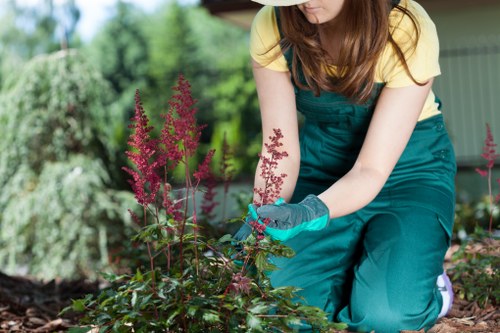
Benefits of Landscaping for Lambeth Residents
Investing in **landscaping in Lambeth** offers numerous benefits beyond just visual improvement:
- Enhanced Property Value: Well-maintained landscapes can significantly increase the market value of your property.
- Improved Mental Health: Access to green spaces has been linked to reduced stress and better mental well-being.
- Environmental Impact: Proper landscaping supports biodiversity, improves air quality, and contributes to urban cooling.
- Energy Efficiency: Strategically planted trees and shrubs can provide shade and windbreaks, reducing heating and cooling costs.
- Community Appeal: Attractive landscapes contribute to the overall appeal of the neighborhood, fostering a sense of pride among residents.
These benefits make landscaping a valuable investment for both individuals and the community as a whole.
Types of Plants Suitable for Lambeth Climates
Choosing the right plants is essential for a thriving landscape in Lambeth. The region's temperate climate supports a variety of species that can flourish with minimal maintenance:
Perennials
Perennial plants return year after year, providing consistent beauty to your garden. Some popular choices include:
- Lavender: Known for its fragrant blooms and drought resistance.
- Hostas: Ideal for shaded areas with their lush foliage.
- Daylilies: Offer vibrant colors and are easy to care for.
Trees and Shrubs
Adding trees and shrubs can create structure and provide shade. Suitable options are:
- Japanese Maple: Adds ornamental value with its unique leaf patterns.
- Boxwood: Perfect for hedges and topiary.
- Rhododendrons: Offer stunning spring blooms.
Annuals
For seasonal color, annual plants are a great addition:
- Pansies: Provide bright colors in cooler months.
- Marigolds: Thrive in sunny spots and resist pests.
- Petunias: Offer a wide range of colors and patterns.
Selecting the right combination of these plants will ensure a vibrant and resilient landscape throughout the year.
Hardscaping Elements to Consider
Incorporating hardscape elements can enhance the functionality and beauty of your outdoor space. Here are some key components to consider:
Patios and Decks
Creating a designated area for outdoor activities is essential. Patios and decks provide space for dining, lounging, and entertaining guests.
Walkways and Pathways
Guiding visitors through your garden with walkways made of stone, gravel, or paving stones adds both practicality and aesthetic appeal.
Water Features
Incorporating ponds, fountains, or waterfalls can introduce a soothing element to your landscape, attracting wildlife and creating a peaceful atmosphere.
Retaining Walls
Retaining walls help manage soil erosion and create different levels in your garden, adding depth and interest to the layout.
Outdoor Lighting
Proper lighting extends the usability of your garden into the evening and highlights key features, enhancing safety and beauty.
- Solar Lights: Energy-efficient and easy to install.
- LED Fixtures: Long-lasting and versatile for various lighting needs.
- Pathway Lights: Illuminate walkways and enhance safety.
These elements can be customized to fit your specific needs and preferences, creating a harmonious and functional outdoor environment.
Seasonal Landscaping Tips for Lambeth
Maintaining a beautiful landscape requires attention to seasonal changes. Here are some tips to keep your garden thriving year-round:
Spring
Spring is the perfect time to plant new flowers and shrubs. **Landscaping in Lambeth** during this season focuses on preparing the soil, planting spring-blooming plants, and pruning overgrown trees and shrubs.
Summer
In summer, focus on watering, weeding, and mulching to retain moisture. It's also a good time to install or maintain irrigation systems and enjoy outdoor living spaces.
Autumn
Autumn requires leaf removal, preparing plants for winter, and planting bulbs for spring blooms. It's also an ideal time for planting trees and shrubs.
Winter
During winter, protect plants from frost, clean garden tools, and plan for the upcoming year. Maintaining hardscape elements and adding winter lighting can keep your landscape attractive even in colder months.
By following these seasonal tips, you can ensure your landscape remains healthy and beautiful throughout the year.
Eco-Friendly Landscaping Practices
Embracing eco-friendly practices in your landscaping can contribute to a sustainable environment. Here are some methods to consider:
Using Native Plants
Native plants are adapted to the local climate, requiring less water and maintenance. They also support local wildlife, promoting biodiversity.
Rainwater Harvesting
Collecting and using rainwater for irrigation reduces dependency on municipal water sources and conserves water.
Composting
Turning garden waste into compost provides a natural fertilizer, enriching the soil and reducing the need for chemical fertilizers.
Permeable Paving
Using permeable materials for walkways and driveways allows rainwater to infiltrate the ground, reducing runoff and preventing erosion.
Solar Lighting
Installing solar-powered lights minimizes energy consumption and utilizes renewable energy sources.
- Reduce Chemical Use: Opt for organic fertilizers and pest control methods to protect the environment.
- Install Efficient Irrigation: Drip irrigation systems provide targeted watering, reducing waste.
- Promote Wildlife: Create habitats for pollinators and other beneficial creatures by selecting appropriate plants.
Implementing these eco-friendly practices not only benefits the environment but also creates a more resilient and sustainable landscape.
Maintenance Tips for a Healthy Landscape
Regular maintenance is essential to keep your landscape looking its best. Here are some tips to ensure a healthy and vibrant outdoor space:
Regular Pruning
Pruning helps maintain the shape of trees and shrubs, encourages healthy growth, and prevents overgrowth that can lead to disease.
Weeding
Removing weeds promptly prevents them from taking over your garden and competing with your plants for nutrients and water.
Fertilizing
Provide essential nutrients to your plants by using appropriate fertilizers based on their specific needs.
Pest Control
Monitor your garden for pests and diseases regularly. Implement integrated pest management strategies to address issues sustainably.
Watering
Ensure that your plants receive adequate water, especially during dry spells. Adjust watering schedules based on weather conditions and plant requirements.
- Mulching: Apply mulch to retain moisture, suppress weeds, and regulate soil temperature.
- Soil Testing: Conduct soil tests to determine pH levels and nutrient content, making adjustments as necessary.
- Seasonal Clean-Up: Remove dead plants, fallen leaves, and debris to maintain a tidy appearance.
Consistent maintenance ensures that your landscape remains attractive, healthy, and sustainable over time.
Choosing Sustainable Materials
Incorporating sustainable materials into your landscape design is an excellent way to reduce environmental impact. Consider the following options:
Recycled Materials
Using recycled stones, bricks, and timber reduces waste and conserves natural resources. These materials can add unique character to your landscape.
Natural Stone
Natural stone is durable and aesthetically pleasing, making it an excellent choice for pathways, patios, and retaining walls.
Composite Decking
Composite decking is a low-maintenance alternative to traditional wood, resistant to rot and insect damage.
Permeable Pavers
Permeable pavers allow water to pass through, reducing runoff and replenishing groundwater supplies.
Sustainable Fencing
Opt for fencing made from sustainably sourced wood or recycled materials to minimize environmental impact.
- Bamboo Fencing: A renewable resource that offers a natural look.
- Recycled Plastic Fencing: Durable and requires minimal maintenance.
- Engineered Wood: Combines the beauty of wood with enhanced durability.
Choosing sustainable materials not only benefits the environment but also adds long-term value and resilience to your landscape.
Integrating Technology into Landscaping
Modern technology can enhance the efficiency and functionality of your landscape. Here are some technological advancements to consider:
Smart Irrigation Systems
Automated irrigation systems use sensors and timers to optimize watering schedules, conserving water and ensuring plants receive the right amount.
Landscape Design Software
Utilizing design software allows for precise planning and visualization of your garden, making it easier to implement your vision.
LED Lighting
Energy-efficient LED lights can be integrated into your landscape design, providing illumination with lower energy consumption.
Solar-Powered Features
Incorporate solar-powered fountains, lights, and other features to reduce reliance on traditional power sources.
Automated Maintenance Tools
Robotic lawnmowers and automated pruning systems can simplify landscape maintenance, saving time and effort.
- Weather-Responsive Controls: Adjust landscape features based on real-time weather data.
- Remote Monitoring: Manage and monitor your landscape systems remotely via smartphone apps.
- Integration with Smart Home Systems: Seamlessly control your outdoor environment alongside indoor smart devices.
Integrating technology into your landscaping can lead to more efficient maintenance, enhanced functionality, and a modern aesthetic.
Budgeting for Your Landscaping Project
Planning your **landscaping in Lambeth** project requires careful budgeting to ensure that you achieve your desired results without overspending. Here are some tips to help you manage costs effectively:
Set Clear Goals
Define what you want to achieve with your landscaping project. Whether it's enhancing curb appeal, creating a relaxing outdoor space, or increasing property value, having clear objectives will guide your budgeting process.
Prioritize Features
Identify which elements are most important to you and allocate your budget accordingly. Prioritizing allows you to focus on must-have features while potentially scaling back on less critical aspects.
Get Multiple Quotes
Obtain estimates from several landscaping companies to compare prices and services. This helps ensure you receive a fair price and can choose the best value for your investment.
Consider Phased Implementation
If budget constraints are a concern, consider implementing your landscaping project in phases. This approach spreads out costs over time and allows for adjustments based on your budget availability.
DIY vs. Professional Services
Evaluate which tasks you can handle yourself and which require professional expertise. While DIY projects can save money, hiring professionals for complex tasks ensures quality and reduces the risk of costly mistakes.
- Planting: Basic planting and maintenance can often be done DIY.
- Hardscaping: Complex installations like patios and retaining walls typically require professional skills.
- Irrigation Systems: Professional installation ensures efficiency and proper functionality.
By carefully planning and prioritizing, you can create a beautiful landscape in Lambeth that fits within your budget.
Hiring Skilled Gardeners and Landscapers
Working with skilled gardeners and landscapers is essential for the success of your landscaping project. Here's how to find and hire the right professionals:
Check Qualifications
Ensure that the landscapers you consider have the necessary qualifications and certifications. This guarantees they have the expertise to handle various aspects of your project.
Review Portfolios
Examine the previous work of potential landscapers to assess their design style and quality. A diverse portfolio indicates versatility and creativity.
Seek Recommendations
Ask friends, family, or neighbors for referrals. Personal recommendations provide insights into the landscaper's reliability and workmanship.
Conduct Interviews
Interview multiple candidates to discuss your project, understand their approach, and gauge their professionalism. Clear communication is crucial for a successful partnership.
Verify References
Contact past clients to inquire about their experience working with the landscaper. This helps verify the landscaper's reputation and the quality of their work.
- Punctuality: Reliable landscapers respect deadlines and stick to schedules.
- Attention to Detail: Skilled professionals pay attention to the finer aspects of design and maintenance.
- Communication Skills: Effective communication ensures that your vision is accurately executed.
Hiring the right team is a critical step in achieving a landscape that meets your expectations and enhances your property's appeal.
Maximizing Small Outdoor Spaces
For those with limited outdoor space in Lambeth, creative landscaping can make a significant impact. Here are some strategies to maximize small areas:
Vertical Gardening
Utilize vertical space by installing trellises, wall-mounted planters, and vertical gardens. This approach allows for more planting without taking up valuable ground space.
Compact Plant Varieties
Choose plants that are well-suited for small gardens, such as dwarf shrubs, compact perennials, and container-friendly plants. These varieties provide beauty without overwhelming the space.
Multi-Functional Furniture
Select outdoor furniture that serves multiple purposes, such as benches with storage or foldable tables. This maximizes functionality while minimizing clutter.
Mirrors and Reflective Surfaces
Incorporate mirrors or reflective surfaces to create the illusion of depth and make the space appear larger.
Smart Lighting
Use strategic lighting to highlight key features and create an inviting atmosphere without overwhelming the space.
- String Lights: Add a whimsical touch and utilize overhead space.
- Lanterns: Provide soft illumination and enhance the ambiance.
- Spotlights: Highlight specific plants or architectural features.
By implementing these strategies, even the smallest outdoor areas in Lambeth can become beautiful and functional landscapes.
Seasonal Planting Calendar
Following a planting calendar ensures that your landscape remains vibrant and healthy throughout the year. Here's a basic guide for **landscaping in Lambeth**:
Spring
- Plant trees and shrubs.
- Start sowing seeds for annuals.
- Prune spent perennials and remove winter debris.
Summer
- Water plants regularly, especially during dry spells.
- Deadhead flowers to encourage more blooms.
- Maintain lawns by mowing and fertilizing.
Autumn
- Plant bulbs for spring flowering.
- Rake fallen leaves and compost them.
- Protect sensitive plants from early frosts.
Winter
- Prune trees and shrubs to promote healthy growth.
- Install protective coverings for delicate plants.
- Plan and design your landscape for the coming year.
Adhering to this calendar helps maintain a consistent and thriving landscape in Lambeth, ensuring that your outdoor space looks its best year-round.
Innovative Landscape Design Ideas
Innovative design can elevate your landscape from ordinary to extraordinary. Here are some creative ideas to inspire your **landscaping in Lambeth**:
Edible Gardens
Incorporate fruits, vegetables, and herbs into your garden design. Edible gardens are both functional and visually appealing, providing fresh produce and adding greenery.
Minimalist Designs
Embrace simplicity with clean lines, monochromatic color schemes, and uncluttered spaces. Minimalist landscaping focuses on functionality and aesthetic elegance.
Zen Gardens
Create a tranquil retreat with elements like sand, rocks, bamboo, and serene water features. Zen gardens promote relaxation and mindfulness.
Wildlife-Friendly Gardens
Design your garden to attract and support local wildlife. Include birdhouses, insect hotels, and native plants to create a habitat for various species.
Artistic Features
Incorporate sculptures, murals, or other artistic elements to add personality and visual interest to your landscape.
- Mosaic Pathways: Add colorful patterns and textures to walkways.
- Water Sculptures: Create dynamic water displays as focal points.
- Garden Art: Use artistic pieces to complement your plantings.
These innovative ideas can help you create a unique and personalized landscape that stands out and reflects your individual style.
Integrating Outdoor Structures
Outdoor structures can add functionality and aesthetic value to your landscape. Here are some structures to consider:
Gazebos and Pergolas
These structures provide shade and a designated area for relaxation or entertainment. They also add architectural interest to your garden.
Sheds and Storage Solutions
Having storage for tools, equipment, and garden supplies helps keep your outdoor space organized and clutter-free.
Greenhouses
A greenhouse allows you to extend your growing season and cultivate plants that require controlled environments.
Fencing and Gates
Proper fencing provides privacy, security, and defines property boundaries. Choose styles that complement your landscape design.
Arbors and Trellises
These structures support climbing plants and add vertical interest to your garden, creating visual pathways and shaded areas.
- Arched Pathways: Enhance walkways with elegant arches covered in flowering vines.
- Privacy Screens: Use tall fences or living walls to create secluded areas.
- Outdoor Kitchens: Equip your garden with cooking facilities for outdoor dining.
Integrating these structures can enhance the utility and beauty of your landscape, providing spaces for various activities and adding dimension to your garden.
Water Conservation in Landscaping
Water conservation is a key aspect of sustainable landscaping. Implement the following practices to reduce water usage:
Drip Irrigation Systems
Drip irrigation delivers water directly to the plant roots, minimizing evaporation and runoff. This method is highly efficient, especially for garden beds and shrubs.
Rain Barrels
Collecting rainwater in barrels provides a free and sustainable water source for your garden, reducing reliance on municipal water supplies.
Drought-Tolerant Plants
Selecting plants that are adapted to low-water conditions reduces the need for frequent watering and conserves water resources.
Mulching
Applying mulch to soil surfaces retains moisture, suppresses weed growth, and regulates soil temperature, all of which contribute to water conservation.
Rain Gardens
Rain gardens are designed to capture and absorb rainwater runoff, preventing flooding and promoting groundwater recharge.
- Proper Plant Selection: Choose plants that thrive in both wet and dry conditions.
- Soil Improvement: Enhance soil permeability to improve water infiltration.
- Strategic Placement: Position rain gardens in areas where water runoff is most likely.
Implementing these water conservation strategies not only benefits the environment but also ensures the longevity and health of your landscape.
Enhancing Privacy in Your Garden
Creating a private outdoor space allows you to fully enjoy your garden without disturbances. Here are some techniques to enhance privacy:
Planting Hedges and Screens
Dense hedges and evergreen screens act as natural barriers, blocking unwanted views and providing a secluded environment.
Fencing
Installing tall fences made from materials like wood, metal, or vinyl can effectively shield your garden from neighboring properties.
Strategic Plant Placement
Position trees and tall plants around the perimeter of your garden to create natural privacy barriers.
Outdoor Structures
Gazebos, pergolas, and trellises can be fitted with curtains or screens to provide additional privacy while maintaining an open feel.
Privacy Glass and Window Treatments
Using privacy glass or decorative window treatments on outdoor structures can prevent outsiders from peering into your garden.
- Vertical Fencing: Provides solid coverage without closing off the space completely.
- Living Walls: Add greenery while serving as a privacy screen.
- Bamboo Fencing: Offers a natural and aesthetically pleasing privacy solution.
By implementing these strategies, you can create a peaceful and private oasis within your Lambeth landscape.
Incorporating Color into Your Landscape
Color plays a significant role in the overall appeal of your landscape. Here are ways to incorporate vibrant hues into your garden:
Plant Selection
Choose a variety of flowering plants that bloom in different seasons to ensure a continuous display of color throughout the year.
Color-Themed Gardens
Create sections of your garden focusing on specific color palettes, such as monochromatic schemes or complementary color combinations.
Colored Hardscapes
Use colorful pavers, tiles, or decorative stones in pathways, patios, and other hardscape features to add visual interest.
Outdoor Furniture and Accessories
Introduce colorful cushions, planters, and decorative elements to enhance the vibrancy of your outdoor spaces.
Lighting
Use colored outdoor lighting to highlight plants and architectural features, adding a dynamic element to your landscape at night.
- LED Lights: Offer a range of colors and are energy-efficient.
- Colorful Lanterns: Add a decorative touch and emit warm, inviting light.
- Spotlights: Focus on specific plants or features for dramatic effects.
Incorporating color thoughtfully can transform your landscape, making it lively and inviting while reflecting your personal style.
Creating Functional Outdoor Spaces
A functional landscape caters to your lifestyle and needs. Here are some ideas to make your outdoor space more practical:
Dining Areas
Set up a dedicated dining area with a table, chairs, and possibly a shade structure like a pergola. This creates a perfect spot for outdoor meals and gatherings.
Play Areas
If you have children, designate a safe and fun play area with appropriate playground equipment and soft ground coverings.
Exercise Zones
Create a space for outdoor workouts with features like yoga mats, exercise stations, or even a small outdoor gym setup.
Storage Solutions
Incorporate solutions like storage benches or sheds to keep outdoor essentials organized and easily accessible.
Workspaces
For those who enjoy outdoor projects, setting up a workspace with a sturdy bench and ample lighting can be highly beneficial.
- Multifunctional Furniture: Use furniture that serves multiple purposes, such as tables with storage.
- Flexible Layouts: Design spaces that can be easily adapted for different activities.
- Accessibility: Ensure that all areas are easily accessible and safe to use.
By designing functional outdoor spaces, you can maximize the usability of your landscape, making it an extension of your living area.
Enhancing Curb Appeal
First impressions matter, and your landscape plays a significant role in your property's curb appeal. Here are some tips to enhance it:
Front Garden Design
Create an inviting front garden with a mix of colorful flowers, well-maintained lawns, and strategically placed shrubs and trees.
Pathway Lighting
Illuminate walkways with stylish lighting to ensure safety and add an elegant touch to your home's exterior.
Entryway Features
Highlight your entryway with decorative door frames, planters, and outdoor art pieces that reflect your personal style.
Seasonal Decorations
Incorporate seasonal elements like wreaths, pumpkins, or ornamental plants to keep your landscape fresh and engaging throughout the year.
Clean and Tidy Maintenance
Regularly maintain your front garden by trimming hedges, removing weeds, and ensuring that lawns are neatly mowed.
- Symmetrical Designs: Balanced arrangements create a sense of order and harmony.
- Focal Points: Use features like a standout tree or a decorative bench to draw attention.
- Consistent Themes: Maintain a cohesive design theme that matches your home's architecture.
Enhancing curb appeal not only makes your property more attractive but also contributes to its overall value.
Choosing the Right Colors and Textures
The interplay of colors and textures can significantly impact the visual dynamics of your landscape. Here’s how to master it:
Color Coordination
Select a color palette that complements your home's exterior and creates a harmonious look. Use a mix of bold and neutral colors to add depth and interest.
Texture Variety
Incorporate plants with different leaf shapes, sizes, and textures to create a rich and layered appearance in your garden.
Seasonal Color Changes
Choose plants that change color with the seasons to keep your landscape vibrant year-round. For example, autumn foliage can add warm tones when other colors fade.
Material Choices
Mix different materials in your hardscape, such as wood, stone, and metal, to add contrast and prevent monotony.
Accent Features
Use colorful pots, benches, or decorative elements to highlight specific areas and add focal points within your landscape.
- Complementary Colors: Pair colors opposite each other on the color wheel for a striking effect.
- Monochromatic Schemes: Use varying shades of a single color for a cohesive and elegant look.
- Accent Plants: Introduce plants that stand out with unique colors or textures to draw attention.
Thoughtful use of colors and textures can make your landscape visually appealing and create a balanced and inviting outdoor space.
Lighting Your Landscape
Proper lighting enhances the beauty and functionality of your landscape, extending its usability into the evening hours. Here are some lighting ideas:
Pathway Lighting
Install lights along walkways to guide visitors safely and add a welcoming glow to your garden paths.
Accent Lighting
Highlight specific features like trees, sculptures, or water elements with focused lighting to create dramatic effects.
Ambient Lighting
Create a soft, general illumination for seating areas and patios, providing a comfortable atmosphere for relaxation and gatherings.
Spotlights and Floodlights
Use spotlights to draw attention to focal points, and floodlights to illuminate larger areas for security and visibility.
Solar Lighting
Opt for solar-powered lights to reduce energy consumption and utilize renewable energy sources. They are easy to install and environmentally friendly.
- String Lights: Add a festive touch and are perfect for outdoor dining areas.
- Lanterns: Provide a stylish and portable lighting option.
- Underwater Lights: Illuminate ponds, fountains, and water features for a stunning visual effect at night.
Strategic lighting not only enhances the aesthetic appeal of your landscape but also improves safety and extends the usability of your outdoor spaces.
Creating a Sustainable Landscape
Sustainability is an essential consideration in modern landscaping. Here are ways to create an environmentally friendly landscape:
Native and Drought-Tolerant Plants
Choosing plants that are well-suited to Lambeth's climate reduces water usage and maintenance requirements, promoting a sustainable garden.
Composting
Recycling garden waste into compost enriches the soil naturally, reducing the need for chemical fertilizers and improving soil health.
Green Roofs and Walls
Implementing green roofs and living walls increases green space, improves air quality, and provides insulation for buildings.
Efficient Irrigation
Installing smart irrigation systems ensures that plants receive the right amount of water, minimizing waste and conserving resources.
Wildlife Habitats
Designing your landscape to support local wildlife, such as pollinators and birds, enhances biodiversity and contributes to a balanced ecosystem.
- Pollinator Gardens: Plant a variety of flowers that attract bees, butterflies, and other pollinators.
- Bird-Friendly Features: Include birdhouses, feeders, and water sources to attract and support bird populations.
- Pest-Repellent Plants: Use plants like marigolds and lavender to naturally deter pests without chemicals.
By focusing on sustainability, you can create a landscape that is both beautiful and environmentally responsible, benefiting both you and the community.
Final Thoughts on Landscaping in Lambeth
**Landscaping in Lambeth** offers endless possibilities to transform your outdoor space into a personal haven or a welcoming environment for visitors. By investing in professional landscaping services, you can ensure that your landscape is not only visually appealing but also functional, sustainable, and tailored to your specific needs.
From selecting the right plants and materials to incorporating innovative design elements and sustainable practices, thoughtful landscaping can significantly enhance the quality of your property and your overall living experience.
Ready to transform your outdoor space? Contact us today to explore the best landscaping solutions Lambeth has to offer and book your service now.
